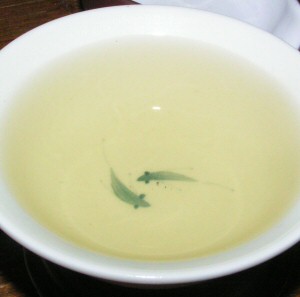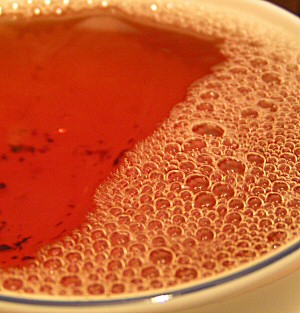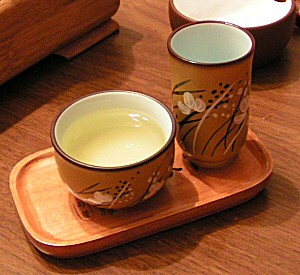Message
Types of Tea
Colors of Tea
After tea became trendy, a great number of tea experts and material on tea have appeared; it is accustomed to start the telling of kinds of teas with the words “There is a pretty great confusion in the classification of teas…”As a matter of fact, there is not any confusion. The whole thing lies in a nutshell — it only depends on the angle of approach to the classification. And on how deep one wants to get into the refinements of the classification. Well, we will not get into the refinements but will have a look at the point from several angles.
The most accurate angle, of course, is the Chinese one. If only for the fact that it was in this country that they first started to ponder over the issues of the classification of teas — during many centuries there was the Imperial Tea Department in China whose task inter alia was to classify teas. They certainly did it not just for the fun of it and not for the love of beauty. Tea is one of the main objects of trade in China. And it is very inconvenient to trade in non-classified goods.
All sorts of tea are produced of the leaves of a tea shrub — and there are no technological obstacles to produce all main kinds and grades of tea out of one consignment of absolutely identical freshly-plucked tea leaves. In practice, of course, a bit different materials are used to produce different kinds of tea — but they are still leaves and unexpanded leaf-buds of the tea shrub — only they are plucked at different times, in different places, of different grade, etc.
 |
||
| E Shen. Green Tea. | ||
Tea of what color will the raw tea stuff turn into depends on the stages of processing it will go trough and the biochemical transformations which will occur in the tea-leaf. The number of the biochemical processes which take place in tea leaves is called fermentation. I will say more about fermentation some other time; at the moment let me stipulatively define fermentation as the process of the conversion of the mixture of tea polyphenols and tea ferments (enzymes) — the formation of theaflavin and thearubigin being the result of this process.
As a matter of fact, the technology of tea producing consists of controlling the fermentation process. Everything — the taste, the flavor, and the color — depends on how far this process will advance.
Green tea is the most ‘natural’. Very often it is referred to as non-fermented, meaning that the conversions in the tea leaf were ceased right after the plucking. Technically, it is impossible, of course, — fermentation in green tea does start — but the process lasts a negligibly short period and thus can be ignored. When producing green tea, the tea leaf is exposed to heating (steaming or frying) right after the plucking. The heating holds up all tea biochemistry and preserves all components of the fresh tea leaf almost absolutely unchanged. After the first round of heating, the tea is rolled and twisted (in rather various ways), then finally dried and drunk. The whole process of producing green tea may take as long as only several hours.
 |
||
| Sikkim Temi. Black Tea. | ||
White tea can also contend for the ‘naturalness’ of green tea. It is normally more fermented than green tea (just a little bit more). When producing white tea, tea leaves are withered a bit and then dried. White tea is not subjected to either rolling or intensive heat treatment. Due to this fact, on the one hand, the fermentation process lasts longer there (in fact, until the leaf is dry); on the other hand, tea leaves (or tea buds) retain their primeval qualities — even their nap. Exaggerating only a little, one can say that white tea is simply plucked and dried tea leaves.
Sometimes yellow teas are singled out as a separate ‘color’. The term ‘yellow tea’ is normally applied to teas produced with the same technology as green teas, the only exception being that they are not dried immediately after rolling, but are withered and fermented a little instead.
Practically all possible exercises are done with tea leaves to produce red tea. The leaves are first withered, then rolled, then put on a special tray, at special temperature and humidity where they get fermented (and become brown-red). After this they are dried. It is believed that the processes of fermentation reach their natural end in red tea. This tea is called ‘fully fermented’; in Europe and Russia it is accustomed to call this tea ‘black’.
But if the plucked tea leaves are withered, rolled, dried, piled up and stored like this for some time (sometimes — some years), then taken out and dried again, you will get puerh. The Chinese also call it ‘black’ — but the name ‘puerh’ is used more frequently. It is also referred to as ‘over-fermented tea’ or ‘tea of secondary fermentation’. These teas are worth devoting them a separate article.
Finally, there are oolongs. Speaking in most primitive terms, they are somewhere in-between green teas (non-fermented) and red teas (fully-fermented). They can be called ‘semi-fermented’, of course. Very often, exclusively for the sake of color continuity, oolongs are ‘painted’, or given a color name. They are called ‘blue-green’, and ‘yellow’, and ‘violet’, and ‘turquoise’ (turquoise being the most common name nowadays). But let us not make up the most suitable color-name for these teas and continue calling them the name the Chinese gave them — oolongs.
 |
||
| Li Shan. Oolong Tea. | ||
Oolongs vary a lot — their diversity is conditioned by the degree of fermentation (it can be very different, ‘semi-fermented’ is a very vast notion), by the production nuances, the grade of raw material, and the locality of their production. I have not come to know the particulars of the oolongs’ inside classification yet. When I do, I will probably write a separate article about it.
That must be it. Despite the technological difficulties accompanying tea production, its classification is very simple: white, green, yellow, oolong, red, and puerh. So, what’s the confusion? The only ambiguity arises due to the fact that Chinese red teas are known in Europe as black. But the language gets round this problem easily. If you want to use the term ‘red tea’, specify: ‘Chinese red tea’. That’s it. And not to have further contradictions, do not call puerhs ‘black’. Then, it will be absolutely clear that when you speak about black tea, you mean European black tea which is mostly Indian, Ceylon, or Kenyan.
Phew… It seems that I’m getting confused myself. To aggravate this confusion, let me offer you my own classification of teas. I like it, although I never use it anywhere.
I divide teas into baby teas, child teas, adolescent teas, youth teas, mature teas, and old teas. In the Chinese classification they correspond to white, green, yellow, oolong, red, and puerh teas.